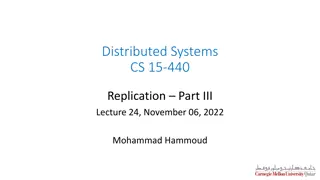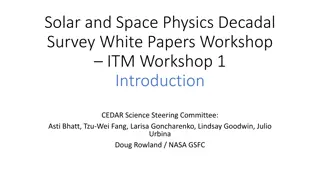Writing Defensible VIS Papers: Tips and Guidelines
Writing a compelling visualization (VIS) paper requires more than just presenting research findings. This seminar by Remco Chang outlines the importance of building a strong argument, structuring arguments effectively, and using resources such as the Heilmeier Catechism and the VALT Prospectus. It also refers to valuable papers by Tamara Munzner and Bob Laramee that offer insights into pitfalls in paper writing and visualization research. By following these guidelines, researchers can enhance the persuasiveness and credibility of their VIS papers.
Download Presentation

Please find below an Image/Link to download the presentation.
The content on the website is provided AS IS for your information and personal use only. It may not be sold, licensed, or shared on other websites without obtaining consent from the author.If you encounter any issues during the download, it is possible that the publisher has removed the file from their server.
You are allowed to download the files provided on this website for personal or commercial use, subject to the condition that they are used lawfully. All files are the property of their respective owners.
The content on the website is provided AS IS for your information and personal use only. It may not be sold, licensed, or shared on other websites without obtaining consent from the author.
E N D
Presentation Transcript
COMP 250-02 | Visualization Seminar Lecture 08: How to Write Defensible VIS Papers COMP 250-02: Visualization Seminar November 17, 2020 Remco Chang 08 How to Write Defensible VIS Papers 1/19
COMP 250-02 | Visualization Seminar Background Writing a paper is just as important as doing the research. Research is not without context an important study is often only important because it moves the community forward at that time. The goal of writing is to persuade the reviewer that your idea is good and your research is sound. A key element of persuasive writing is to make all of your statements and arguments defensible. Remco Chang 08 How to Write Defensible VIS Papers 2/19
COMP 250-02 | Visualization Seminar Material to Help Structure Your Arguments The Heilmeier Catechism by George Heilmeier, a former DARPA director Originally designed for reviewing proposals, but aspects of it fit well for paper writing The VALT Prospectus Tamara has this practice that her students are required to do a presentation as if giving a talk at the VIS conference before starting to do the research Tamara Munzner s paper on writing pitfalls Bob Laramee s paper on writing visualization papers Remco Chang 08 How to Write Defensible VIS Papers 3/19
COMP 250-02 | Visualization Seminar Heilmeier Catechism Remco Chang 08 How to Write Defensible VIS Papers 4/19
COMP 250-02 | Visualization Seminar VALT Prospectus (based on Heilmeier Catechism) https://valt.cs.tufts.edu/pub/ 1. Abstract / Introduction 2. Once Sentence Summary 3. Contributions (list 3) 4. Project/Paper Type 5. Audience and Needs 6. Approach 7. (Best Case) Impact 8. Milestones 9. Obstacles (Major and Minor) 10. Additional Resources Needed 11. Literature Review 12. Define Success Remco Chang 08 How to Write Defensible VIS Papers 5/19
COMP 250-02 | Visualization Seminar Tamara s Paper on Pitfalls in Writing Papers Process and Pitfalls in Writing Information Visualization Research Papers Tamara Munzner, 2008 https://www.cs.ubc.ca/labs/imager/tr/2008/pitfalls/pitfalls. pdf Read it for: A list of the types of papers and how to structure them (algorithm, design studies, evaluation, etc.) A list of common pitfalls in writing (visualization) papers E.g. My Picture Speaks For Itself: You should talk the reader through how your visual representation exposes meaningful structure in the dataset, rather than simply assuming the superiority of your method is obvious to all readers from unassisted inspection of your result images Remco Chang 08 How to Write Defensible VIS Papers 6/19
COMP 250-02 | Visualization Seminar Datavis Bob s Paper How to Write a Visualization Research Paper: A Starting Point Bob Laramee, 20011(??) https://cs.swan.ac.uk/~csbob/research/how2write/lara mee09how2write.pdf Read it for: A guideline on the typical structure of a (VIS) paper It s a beginner s guide to writing a paper (whereas Tamara s paper is more about how to avoid pitfalls) Remco Chang 08 How to Write Defensible VIS Papers 7/19
COMP 250-02 | Visualization Seminar What are your Questions? Remco Chang 08 How to Write Defensible VIS Papers 8/19
COMP 250-02 | Visualization Seminar Paper Writing Strategies We will talk about paper writing at three levels: High-level structure 1. Mid-level flow 2. Low-level (sentence-level) pitfalls 3. Remco Chang 08 How to Write Defensible VIS Papers 9/19
COMP 250-02 | Visualization Seminar High-Level Structure Your Writing Goals: 1. Write for the audience. Don t just write what you want to say, write what the audience needs to hear. This is hard to do. You don t always know who your audience is. How would you tailor your writing to them? Get your audience to nod. If your reviewer nods throughout reading the paper, at the end a reviewer would feel compelled to accept the paper. The converse of this is: don t write sentences or arguments that make the reader shake their head or wonder quizzically if the arguments might be false Your reader is lazy. So make your writing predictable The reader should know what s coming next (structurally). You are not writing a mystery novel. There should be no surprises in the middle of reading a paper. 2. 3. Remco Chang 08 How to Write Defensible VIS Papers 10/19
COMP 250-02 | Visualization Seminar High-Level Structure, Recursive Writing For point 3 (make your writing predictable ), two ways to accomplish this is to use: Upside-down Pyramid writing Say the most important things at the start of the paper, start of the section, start of a paragraph. Fill in the details afterwards. Recursive writing Your Abstract should make clear what the paper is about (and what arguments you will be using) Your Intro is an expanded version of the Abstract. Your Paper is an expanded version of the Intro. Note: Remember to connect your writing back to the main points of the paper In terms of recursion talk, this is saying that when you bottom out in the recursive loop and go all the way back to the top of the recursion, you need to remind the reader where they are in the overall process Remco Chang 08 How to Write Defensible VIS Papers 11/19
COMP 250-02 | Visualization Seminar Mid-Level Flow EXAMPLE 1 Experiment 1 blah blah blah In conclusion, in Study 1, we demonstrate that blah blah blah EXAMPLE 2 Experiment 1 blah blah blah In conclusion, in Study 1, we demonstrate that blah blah blah Experiment 2 While experiment 1 was great, it was lacking in that it didn t do XXXX. In experiment 2, we address this problem by XXXX Experiment 2 In experiment 1, we established that XXXX. In a follow-up experiment, we expanded on this result and XXXX. Remco Chang 08 How to Write Defensible VIS Papers 12/19
COMP 250-02 | Visualization Seminar Low-Level (Sentence-Level) Pitfalls For point 2 ( Get your audience to nod ), it is important that your writing is agreeable. Here are some ways to do so: Avoid weasel-y words Most people think that bar charts are better some researchers believe that Who are most people ? As a reader I get mad at these sentences because I cannot agree or disagree with this statement Note: broader claims can be made in a discussion section E.g. our results suggest that or our results might have broader implications Remco Chang 08 How to Write Defensible VIS Papers 13/19
COMP 250-02 | Visualization Seminar Low-Level (Sentence-Level) Pitfalls Provide evidence Visualization is increasingly becoming a commonly used tool in data science I might agree with this, but if you provide a citation, I will be so much more comfortable in agreeing with this statement Avoid adverbs, adjectives, and over claiming Our tool is muchbetter than vs. Our tool is better than The word much isn t defensible. It just annoys the reader because there is no way to quantify much Remco Chang 08 How to Write Defensible VIS Papers 14/19
COMP 250-02 | Visualization Seminar What are your Questions? Remco Chang 08 How to Write Defensible VIS Papers 15/19
COMP 250-02 | Visualization Seminar How to Write an Abstract https://valt.cs.tufts.edu/pub/abstract-template.html There are many ways to write a compelling abstract. However, if you are struggling with writing yours, here's a default template on how you might write one. sentence 1: background sentence 2: missing gap (e.g. "however, there's a problem blah") sentence 3: why is this bad sentence 4: "In this paper, we propose SystemX" sentence 5, 6 (and/or 7): technical depth on what SystemX is. That is, what is the secret sauce that makes SystemX possible? sentence 8: benefits of SystemX, aka the primary contribution of the paper (note that this should echo sentence 3 in that SystemX should have addressed the problem stated in sentence 3) sentence 9: "We evaluate SystemX..." sentence 10: "Our results indicate that (problem stated in sentence 3 is no longer a problem)..." Remco Chang 08 How to Write Defensible VIS Papers 16/19
COMP 250-02 | Visualization Seminar A system paper (Dylan's VIS 2019 paper): Deep learning models require the configuration of many layers and parameters in order to get good results. However, there are currently few systematic guidelines for how to configure a successful model. This means model builders often have to experiment with different configurations by manually programming different architectures (which is tedious and time consuming) or relying on purely automated approaches to generate and train the architectures (which is expensive). In this paper, we present SystemX, a visual analytics tool that allows a model builder to discover a deep learning model quickly via exploration and rapid experimentation of neural network architectures. In SystemX, the user explores the large and complex parameter space for neural network architectures using a combination of global inspection and local experimentation. Through a visual overview of a set of models, the user identifies interesting clusters of architectures. Based on their findings, the user can run ablation and variation experiments to identify the effects of adding, removing, or replacing layers in a given architecture and generate new models accordingly. As a result, a model builder can build deep learning models quickly, efficiently, and without manual programming. We evaluate SystemX through user studies with four experts in deep learning. The results indicate that using SystemX users are able to gain new understanding of the model space, and are able to use such insights to discover novel and improved neural architectures. Remco Chang 08 How to Write Defensible VIS Papers 17/19
COMP 250-02 | Visualization Seminar Exercise! Write an Abstract! Pretend that you have just invented Piecharts as a new visualization technique. Write an abstract for the paper that you ll be submitting to VIS. Questions: What kind of paper is this? What are the highlights of pie charts? How do you evaluate? Remco Chang 08 How to Write Defensible VIS Papers 18/19
COMP 250-02 | Visualization Seminar Cheat Sheet Questions for the class What kind of paper is this? Answer: Technique What are the highlights of pie charts? Answer 1: pie charts are similar to bar charts in that they show magnitudes per object Answer 2: but pie charts are better in that they show parts to whole relations Answer 3: pie charts are aesthetically pleasing and easier to read for some users How do you evaluate? Answer 1: Study 1: A-B study of pie vs. bar. Quantitative measure that pie is better at parts to whole Answer 2: Study 2: Qualitative study to show that pie charts are: Aesthetically pleasing Easy to read and understand Remco Chang 08 How to Write Defensible VIS Papers 19/19























